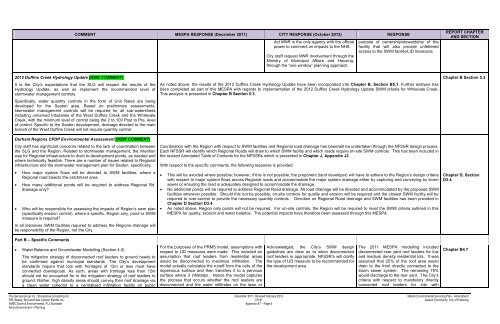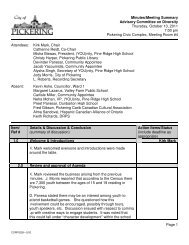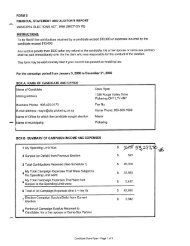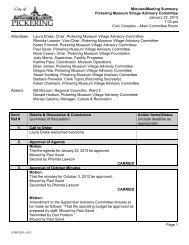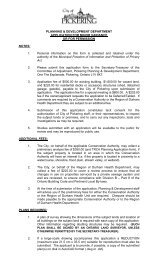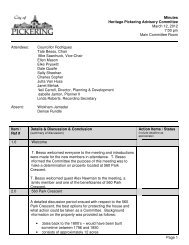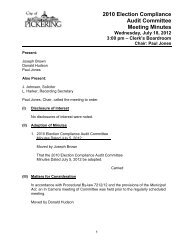Chapter A - Introduction - City of Pickering
Chapter A - Introduction - City of Pickering
Chapter A - Introduction - City of Pickering
You also want an ePaper? Increase the reach of your titles
YUMPU automatically turns print PDFs into web optimized ePapers that Google loves.
COMMENT MESPA RESPONSE (December 2011) CITY RESPONSE (October 2012) RESPONSE<br />
Act MNR is the only agency with the <strong>of</strong>ficial<br />
power to comment on impacts to the NHS.<br />
<strong>City</strong> staff request MNR involvement through the<br />
Ministry <strong>of</strong> Municipal Affairs and Housing,<br />
through the “one window” planning approach.<br />
purpose <strong>of</strong> ownership/stewardship <strong>of</strong> the<br />
facility that will also provide unfettered<br />
access to the SWM facility/LID measures<br />
REPORT CHAPTER<br />
AND SECTION<br />
2012 Duffins Creek Hydrology Update (NEW COMMENT)<br />
It is the <strong>City</strong>’s expectations that the SLG will respect the results <strong>of</strong> the<br />
Hydrology Update, as well as implement the recommended level <strong>of</strong><br />
stormwater management controls.<br />
Specifically, water quantity controls in the form <strong>of</strong> Unit Rates are being<br />
developed for the Seaton area. Based on preliminary assessments,<br />
stormwater management controls will be required for all sub-watersheds<br />
including unnamed tributaries <strong>of</strong> the West Duffins Creek and the Whitevale<br />
Creek, with the minimum level <strong>of</strong> control being the 2 to 100 Post to Pre. level<br />
<strong>of</strong> control. Specific to the Seaton development, drainage directed to the main<br />
branch <strong>of</strong> the West Duffins Creek will not require quantity control.<br />
Durham Regions CPDP Environmental Assessment (NEW COMMENT)<br />
<strong>City</strong> staff has significant concerns related to the lack <strong>of</strong> coordination between<br />
the SLG and the Region. Related to stormwater management, the intention<br />
was for Regional infrastructure to drain to development ponds, as needed and<br />
where technically feasible. There are a number <strong>of</strong> issues related to Regional<br />
infrastructure and the stormwater management plan for Seaton, specifically;<br />
• How major system flows will be directed to SWM facilities, where a<br />
Regional road bisects the catchment area.<br />
• How many additional ponds will be required to address Regional Rd.<br />
drainage only?<br />
• Who will be responsible for assessing the impacts <strong>of</strong> Region’s swm plan<br />
(specifically erosion control), where a specific, Region only, pond or SWM<br />
measure is required?<br />
In all instances SWM facilities required to address the Regions drainage will<br />
be responsibility <strong>of</strong> the Region, not the <strong>City</strong>.<br />
As noted above, the results <strong>of</strong> the 2012 Duffins Creek Hydrology Update have been incorporated into <strong>Chapter</strong> B, Section B5.1. Further analysis has<br />
been completed as part <strong>of</strong> this MESPA with regards to implementation <strong>of</strong> the 2012 Duffins Creek Hydrology Update SWM criteria for Whitevale Creek.<br />
This analysis is presented in <strong>Chapter</strong> B Section 5.3.<br />
Coordination with the Region with respect to SWM facilities and Regional road drainage has been/will be undertaken through the NFSSR design process.<br />
Each NFSSR will identify which Regional Roads will drain to which SWM facility and which roads require on-site SWM controls. This has been included in<br />
the revised Annotated Table <strong>of</strong> Contents for the NFSSRs which is presented in <strong>Chapter</strong> J, Appendix J2.<br />
With respect to the specific comments, the following response is provided:<br />
• This will be avoided where possible; however, if this is not possible, the proponent (land developer) will have to adhere to the Region’s design criteria<br />
with respect to major system flows across Regional roads and accommodate the major system drainage either by capturing and conveying by storm<br />
sewer or ensuring the road is adequately designed to accommodate the drainage.<br />
• No additional ponds will be required to address Regional Road drainage. All road drainage will be directed and accommodated by the proposed SWM<br />
facilities wherever possible. Should this not be possible, on-site controls for quality and erosion will be required and the closest SWM facility will be<br />
required to over-control to provide the necessary quantity controls. Direction on Regional Road drainage and SWM facilities has been provided in<br />
<strong>Chapter</strong> D Section D3.4.<br />
• As noted above, Region only ponds will not be required. For on-site controls, the Region will be required to meet the SWM criteria outlined in this<br />
MESPA for quality, erosion and water balance. The potential impacts have therefore been assessed through this MESPA.<br />
<strong>Chapter</strong> B Section 5.3.<br />
<strong>Chapter</strong> D, Section<br />
D3.4<br />
Part B – Specific Comments<br />
• Water Balance and Groundwater Modelling (Section 4.0)<br />
The mitigation strategy <strong>of</strong> disconnected ro<strong>of</strong> leaders to ground needs to<br />
be confirmed against municipal standards. The <strong>City</strong>’s development<br />
standards require that lots with frontages <strong>of</strong> 12m or less must have<br />
connected downspouts. As such, areas with frontage less than 12m<br />
should not be accounted for in the mitigation strategy <strong>of</strong> ro<strong>of</strong> leaders to<br />
ground. Rather, high density areas should convey their ro<strong>of</strong> drainage via<br />
a clean water collector to a centralized infiltration facility on public<br />
For the purposes <strong>of</strong> the PRMS model, assumptions with<br />
respect to LID measures were made. This included an<br />
assumption that ro<strong>of</strong> leaders from residential areas<br />
would be disconnected to maximize infiltration. The<br />
model actually calculates the run<strong>of</strong>f from the cells <strong>of</strong> the<br />
impervious surface and then transfers it to a pervious<br />
surface where it infiltrates. Hence the model captures<br />
the process that occurs whether the ro<strong>of</strong> leaders are<br />
disconnected and the water infiltrates on the lawn or<br />
Acknowledged, the <strong>City</strong>’s SWM design<br />
guidelines are clear as to when disconnected<br />
ro<strong>of</strong> leaders is appropriate. NFSSR’s will clarify<br />
the type <strong>of</strong> LID measure to be recommended for<br />
the development area.<br />
The 2011 MESPA modelling included<br />
disconnected rear yard ro<strong>of</strong> leaders for low<br />
and medium density residential lots. It was<br />
assumed that 25% <strong>of</strong> the ro<strong>of</strong> area would<br />
drain to the front directly connected to the<br />
storm sewer system. The remaining 75%<br />
would discharge to the rear yard. The <strong>City</strong>’s<br />
criteria with respect to mandatory directly<br />
connected ro<strong>of</strong> leaders for lots with<br />
<strong>Chapter</strong> B4.7<br />
The Sernas Group Inc., Stonybrook Consulting Inc. December 2011, Revised February 2013 Master Environmental Servicing Plan - Amendment<br />
SPL Beatty, Bird and Hale Limited, Earthfx Inc. 07161 Seaton Community, <strong>City</strong> <strong>of</strong> <strong>Pickering</strong><br />
AMEC Earth & Environmental, R.J. Burnside Appendix A7 – Page 6<br />
Amos Environment + Planning


